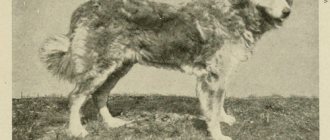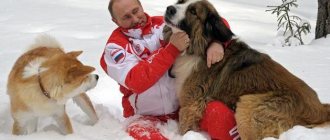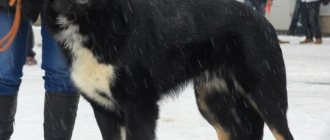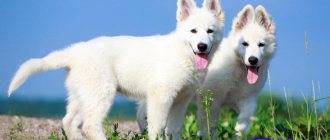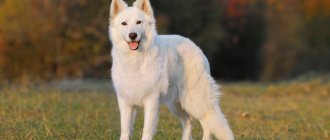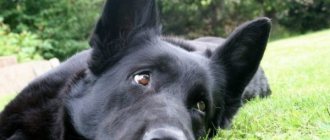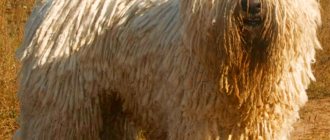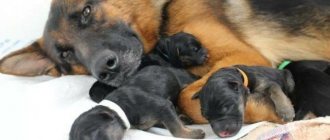Breed characteristics
| Short description | |
| Origin: | USSR, Tavria |
| Conditions of detention: | In an enclosure, on the territory of a country house, free-range |
| Purpose: | Shepherd, guard |
| Color: | White, fawn, gray, piebald, in combination with spots of the same colors |
| Wool length: | Long, at least 15 cm, rough, wavy; there is a thick undercoat; there is a characteristic bang that covers the eyes; hair is present on the body, tail, paws and head |
| Adult dog size: | Height of males from 65 cm; females from 60 cm Weight from 35 kg to 50 kg |
| Average life expectancy: | 14-15 years old |
| Walk: | Required 2 times a day, lasting at least an hour; free range preferred |
| Physical activity needs: | Significant need for high-intensity aerobic physical activity |
| Fédération Cynologique Internationale (FIC) classification: | Recognized by the FCI in 1983 Group 1. Herding and cattle dogs, except Swiss cattle dogs / Section 1. Shepherd dogs |
| Puppy price: | From 15 thousand rubles to 60 thousand rubles (individuals purchased for participation in exhibitions) |
Health
The South Russian Shepherd is a long-liver; with proper care, it can live 15-16 years . There are cases where Yuro lived to be 17-18 years old.
This is not surprising, Ioujnorousskaia Ovtcharka is naturally endowed with a strong body and strong immune defense.
The good health of a shepherd is not a reason for the owner not to care about maintaining it. The owner should visit the veterinary clinic with the pet 1-2 times a year for a preventive examination by specialists.
During such visits, X-ray examinations and tests should be performed.
There is no need to neglect regular deworming and routine vaccination. Treatment against ticks and fleas is also required.
Although it is worth noting that skin parasites in rare cases cling to the South Russian Shepherd due to the extremely dense undercoat.
If you plan to engage in breeding work, then childbirth in YuRO usually takes place without complications.
In rare cases, consultation and assistance from a veterinarian may be necessary. The first mating should be carried out only after the third heat. At this time, the shepherd’s body is completely ready for pregnancy and successful childbirth.
History of the origin of the species
The first mention of the ancestors of the South Russian Shepherd Dog is usually attributed to 1797 . At the end of the 18th century, at the state level, the task was set to organize sheep breeding in the undeveloped territories of the Tauride steppes. For this purpose, fine-wooled Spanish sheep were brought to the region of modern Zaporozhye and Kherson region. Along with the flocks, special shepherd dogs – small Asturian Shepherd Dogs – were also brought to the Russian Empire.
However, representatives of this breed could not provide practical assistance to local sheep farmers. The animals were well trained to maintain order in the herd. But in the conditions of the southern, scorching heat, and in the absence of water, they were unable to cope with the main task. Being short and relatively weak in build, they were unable to protect their herds from steppe wolves.
There was a need to create a different type of powerful guard dog that would also have exceptional herding qualities. Thus, the idea of crossing imported individuals with local breeds - Tatar Shepherd Dogs and Greyhounds - appeared. The result of selection was the South Russian Shepherd Dog. Combining the strength and endurance of the first breed, and the tall stature and viciousness of individuals of the second species, the dog became an unrivaled guard.
The main distribution area of the South Russian Shepherd was Crimea. The main selection work was carried out in the large estate of Askania-Nova, located in what is now Ukraine. The documentary archive of this estate, which has survived to this day, confirms that it was here in 1856 that the largest number of individuals was recorded.
The Civil War made adjustments to the development of the breed, and the number of dogs was greatly reduced. The individuals that survived on the farms of individual shepherds and ordinary fans of this breed became the basis for restorative breeding. It was organized in the city of Dzhankoy with the support of the state. In general, the nursery staff successfully completed the task. In a short time, lines were bred that were not inferior to specimens brought from the territory of Askania-Nova and from other cities of the country.
Currently, the breed is not in high demand in the European part of Russia, but in the southern regions the number of fans is gradually increasing.
Purpose of the breed
The South Russian Shepherd dog breed was bred to help shepherds herd sheep and protect the flock from wolves. From an early age, dogs were instilled with the necessary qualities, selecting the best representatives in terms of appearance and character for procreation.
As a result, the Yuzhaks coped with the task so well that sometimes 3-4 dogs of this breed were enough to guard a flock of 1,500 sheep. In addition, South Russian Shepherd dogs aggressively and selflessly guarded the house and yard territory of their owners.
Even now they are used as security guards and watchmen, whom no outsider can pass by. In some European countries, southerners can be found among the police and guard units. They also make good detectives and rescuers.
Distinctive features
The South Russian Shepherd has the following distinctive features:
- The skull is slightly elongated, wedge-shaped; the frontal part is relatively wide, the occipital part is clearly formed.
- The ears are triangular, medium-sized, drooping, and set high.
- The eyes are oval-shaped, small, dark in color, and set wide apart.
- The eyelids are dense and dry.
- The stop is expressed implicitly.
- The muzzle is narrowed and completely covered with hair.
- The nose is large; The lobe is black, voluminous.
- The teeth are large, white, 42 pieces.
- bite .
- The type of constitution is dry.
- The physique is strong, the muscles are powerful and dry.
- The croup is wide.
- The skin is dense, smooth; folds are completely absent.
- The chest is flat and protrudes forward.
- The neck is slightly elongated, dry, and set high.
- The loin is muscular, wide, shortened, slightly convex.
- The limbs are straight, parallel, wide, at a slight angle.
- The paws are oval, completely covered with long hair.
- The tail is long, set low, dropped down, the end has the shape of a half ring.
- Movements are free; gait - trot.
- The coat is long, at least 15 cm, coarse, wavy; there is a thick undercoat; there is a characteristic bang that covers the eyes; hair is present on the body, tail, paws and head.
- Color: white, fawn, gray, piebald, in combination with spots of the same colors.
Breed standard - dimensions
The South Russian Shepherd is a large, physically developed dog with long, thick hair.
Dimensions:
- height at the withers - 65 cm in males and about 62 cm in females;
- weight - 35-50 kg.
Breed characteristics:
- strong, not too massive body;
- elongated head with a smooth transition from forehead to muzzle;
- black nose;
- ears are triangular, small;
- the tail is of medium length, abundantly covered with hair and rounded at the end.
The shepherd's magnificent white coat deserves special attention. It tightly envelops the dog's paws, reminiscent of felt boots or UGG boots. The head is completely covered with thick hair, and the long bangs touch the nose.
Color options:
- white;
- smoky white;
- smoky gray;
- pale yellow;
- white with areas of pale yellow and gray.
The undercoat of Yuzhaks is dense and very durable. It comes in gray and bluish shades.
The length of the pile of South Russian Shepherds is at least 10 cm. It saves the dog from hypothermia and overheating. Such a durable fur coat helps to survive bad weather and attacks from predatory animals: their teeth have difficulty breaking through the woolen “armor.” In addition, the long fur on the face protects sensitive eyes from dust and small debris.
Photo of an adult dog
Origin of the breed
The Old Russian Shepherd has been known for several centuries. Its distant ancestor, the Asturian Shepherd Dog, was brought from Spain to the Crimea back in the 17th century, where it gradually mixed with local herding dogs. A lot of work on breeding the breed was done by sheep farmers, who bred dogs in the semblance of modern nurseries, selecting the largest and strongest ones to guard the sheep. This is how the breed of Russian shepherd dog emerged, which was noted at exhibitions at the beginning of the 20th century.
After the revolution and civil war, the breed was in danger of extinction. It was restored with great difficulty, thanks to the dogs preserved by shepherds in remote areas. In the 30s, the name of the South Russian Shepherd was officially approved, and the first breed standard was drawn up. During World War II, the Russian Shepherd almost disappeared again - at the end of the 40s, there were only a few dozen representatives of the breed in the entire country.
South Russian Shepherd Dogs were originally bred to guard herds of sheep.
It was very difficult to revive the South Russian Shepherd. Experts had to cross the surviving dogs with other breeds similar in appearance. But it has not yet been possible to restore the breed in full. In modern conditions, professionals and amateurs work together to breed and improve the South Russian Shepherd.
Photos of puppies
Care
When keeping a South Russian Shepherd, you will have to pay great attention to caring for its long hair. The dog must be brushed daily, first with a coarse brush, then with a comb with metal teeth, otherwise the soft undercoat will become tangled. Particularly careful care will be required during shedding, when the fur comes off in large clumps. It is very difficult to wash a dog entirely; it is not recommended to do this more than several times a year.
Both ready-made dry and wet food and natural food are suitable for feeding the dog. Despite its large size, the South Russian Shepherd requires relatively little food; overfeeding can lead to diseases. In order for natural nutrition to be correct, it is recommended that a diet be drawn up by a veterinarian.
IMPORTANT: It is better to choose ready-made food from premium brands, then you can be sure of the health of your pet. Complete feeds are verified in composition and calories, balanced in the content of vitamins and minerals, so natural food cannot be given in addition to them.
Features of character and behavior
Despite the fairly balanced type of higher nervous activity, the South Russian Shepherd is not recommended for people with a soft, compliant character. Strong animals, capable of making independent decisions, these dogs must feel the unconditional leadership of the owner.
Considering the presence of an innate defensive reaction in an active form, as well as pronounced protective and watchdog qualities, a South Russian Shepherd puppy must be taught obedience from the first moments of its appearance in the house. Otherwise, by the time of puberty, the dog, especially the male, may become uncontrollable.
Some owners note that the genetic predisposition to protect their puppies in this breed sometimes transforms into a desire to protect small members of the human family . At the same time, security measures can be accompanied by aggressive actions and cross the boundaries of ordinary affection and care.
Contact of an animal that has not completed the OKD course with small children in the absence of the owner is excluded.
Advantages
“Southerners” have a lot of advantages. The main advantages of this breed over other species are the following characteristics:
- Exceptional security and protective working qualities, lightning-fast reaction, very sensitive hearing.
- High intelligence, ability to quickly and accurately follow human commands.
- Capable of performing guard duty.
- They are easy to train and smart.
- They have an innate desire for discipline.
- They are unpretentious, do not require special conditions, are able to survive for a long time without food and water, and are not influenced by the climatic environment.
- A pronounced protective instinct that must be controlled with the help of OKD and the strong, calm character of the owner. In the absence of these conditions, it turns into a strong disadvantage that poses a threat to the property and lives of others.
Flaws
The main disadvantages should be noted:
- Wayward character;
- Malice, aggressiveness, extreme distrust of strangers, can attack without warning;
- Possible manifestations of aggression towards other animals;
- with an insufficient level of control, aggressive reactions towards family members and others are likely;
- Excessive excitability;
- Not suitable for people with a soft character, impatient and unbalanced;
- Not suitable for owners who have no experience interacting with service dogs; for families with small children; elderly people;
- Cannot be kept in an apartment;
- Requires significant daily physical activity of a high intensity aerobic nature; free range is preferred;
- Regular OKD training is required; in the absence of regular training, the animal’s reaction to an unexpected, loud and suspicious sound is unpredictable and can pose a danger to those nearby;
- Careful grooming is required.
Character
Ioujnorousskaia Ovtcharka is a self-confident, self-sufficient and unusually intelligent dog. Like her distant shepherd ancestors, she is capable of making independent decisions, which often manifests itself in stubbornness and willfulness.
The South Russian Shepherd is friendly towards all family members, they are all under its reliable protection. But only one person can be its leader.
In most cases, the shepherd dog determines its owner for itself. This person should be an authority for her, a “leader”. In the absence of such, the YuRO itself will imagine itself as the leader in the house.
A child cannot be the owner of a Yuzhak. So children should not give such a dog as a pet. In a child-YURO union, it is the dog that will become the leader, which is unacceptable.
The Yuzhak is friendly with children and is ready to defend them at the cost of his life. But adults should always show the shepherd that a child, even of the smallest age, occupies a higher place in the family than she does.
She gets along well with pets, provided that they grew up with her or lived in the house before she arrived. No particular conflicts arise unless no one claims to be the leader. The South Russian Shepherd is prone to dominance.
YURO is a rather aggressive and vicious breed towards strangers. She is infinitely devoted to her owners and ideally performs guard duty from a young age. Each dog is individual in its own way. Her character and behavior largely depend on her upbringing and conditions of detention.
Care and maintenance
It is recommended to keep the South Russian Shepherd Dog in a large enclosure on the territory of a country house or in an unfenced area with an awning, allowing it to move freely around the site. The coarse, dense coat of dogs allows them to be in open spaces in any weather without consequences.
- Animals can easily tolerate heat, heat and stuffiness, as well as frosty days. This is one of the undoubted advantages when choosing this breed. The thick undercoat and hair present on the body, tail, paws and head make them practically invulnerable to any climatic conditions.
Keeping on a leash is not allowed. This can lead to anger and uncontrollable aggression.
- Long hair also dictates special conditions for caring for the dog.
- bathe no more than 1-2 times a year, using special shampoos with conditioner to maintain wavy hair in ideal condition.
- The presence of bangs falling over the eyes and hair on the ears reliably protect these organs from the penetration of dirt, debris and dust. It is quite enough to conduct external preventive examinations once a week.
- South Russian Shepherds have strong, white teeth , and, with proper nutrition, which includes meat and raw vegetables, do not require increased attention to them. It is recommended to examine the oral cavity 1-2 times a month. It is advisable to carry out the removal of plaque or tartar in a specialized veterinary clinic. This is especially true for individuals with a high level of excitability.
- claws , with sufficient physical activity, grind down on their own.
Nutrition
The basis of the diet of the South Russian Shepherd should be natural food - beef, sea fish, fermented milk products, eggs, cereals and raw vegetables.
A puppy up to 6 months of age is fed 5-6 times a day, with 50-60% of the daily intake being meat. The volume of the daily portion ranges from 700 g. up to 2.0 l . Over the age of 6 months, the number of feedings gradually decreases and by the first year of life it is 2 times - in the morning and in the evening.
At the same time, the volume of food and the ratio of products decreases. Morning feeding accounts for 300-350 grams . fermented milk products. Evening feeding includes 450-550 g. meat, 80-100 gr . raw vegetables (excluding onions, potatoes, cabbage, peas). If necessary, the dog’s diet can be supplemented with porridge - buckwheat and rice are mainly used for these purposes.
It is important to use vitamin complexes during natural feeding, especially during the puppy’s growth period.
It is advisable to establish a strict diet for the South Russian Shepherd and feed it “by the hour.” Meals are not allowed less than two hours before the start of active work, free walking, or going on guard duty.
Dry food is not recommended for use in the diet of the South Russian Shepherd.
If natural food is not available, it is preferable to use super premium food: ROYAL CANIN, EUKANUBA, PROPLAN (PURINA), BOSCH, HILL`S. The feed contains proteins, fats and carbohydrates in the required proportions. In this case, no additional vitamin supplements are required.
Health
"White giants" have excellent health. Strong, resilient, they practically do not get sick and often live to an advanced age for large dogs - 15-17 years. Necessary conditions for maintaining tone are:
- balanced diet, especially up to 12 months;
- daily intense physical activity, free walking.
Vaccinations
Vaccination of the South Russian Shepherd is mandatory.
After the first injection at 1.5-2 months, the puppy is quarantined. During the period from 12 to 14 days after vaccination, walking, swimming, and all contacts of the puppy with other animals are excluded. An increase in temperature and diarrhea are often noted. The vaccine is given simultaneously against plague, parainfluenza, hepatitis and parvovirus enteritis. After 21 days, revaccination is carried out. Usually, the puppy’s reaction does not cause symptoms of the first vaccine and is much easier to tolerate.
At 6 months, the puppy must receive a rabies vaccination, as well as a comprehensive vaccine. The timing of vaccinations is necessarily shifted if at this moment the dog undergoes a change of teeth. Quarantine is advisable and depends on the condition of the dog.
At 12 months, the dog is considered an adult and is vaccinated according to the 6-month schedule. Starting at this age, vaccination is carried out every year.
Diseases
Diseases characteristic of the South Russian Shepherd are few and come down to diseases typical of large breed dogs - arthritis and joint dysplasia . The disease mainly affects males over the age of 10-11 years.
Walk
Walking the dog is required on a regular basis, at least 2 times a day, for at least an hour. The ideal mode of physical activity is free range, moving around a large area. Owners of South Russian Shepherds note that the animals need to be given the opportunity to walk along a variety of routes.
These shepherds have a pronounced “possessive” instinct, and often the second time they consider the path they have traveled as a “protection zone.” The best option would be to keep the dog on a farm where they can fully realize their genetic herding predisposition.
Grooming
The coat of South Russian Shepherds requires careful care . To prevent thick hair from falling off, it must be combed regularly. Outside the molting period, the procedure is carried out 1-2 times a week with a special comb with teeth of different lengths. This type of brush is ideal for long coats and dense undercoats.
Dogs shed heavily, so during these seasonal periods, twice a year, the procedure must be carried out daily until excess hair is completely removed. For combing, use a comb with sparse teeth and blunt ends.
Grooming the animal is not recommended due to slow hair growth.
The exception is the bangs and fur on the inner surface of the animal's ears. It is permissible to use small scissors to cut (thin) the wool on these parts.
Diseases and care of South Russian Shepherds
In general, the health of the Yuzhaks is stable, and proper care will allow the pet to live next to its owner for many years, but careful care is still required. First of all, you need to take care of your dog's ears. The point is in the particularity of their structure. Fitting tightly to the head and covered with thick hair, they are susceptible to various infections leading to otitis media. For the same reason, special attention must be paid to eyes hidden by bangs.
As for wool, caring for it requires compliance with several rules:
- At the beginning of spring, be sure to comb out the fluff from the dog’s inner undercoat that has accumulated over the winter;
- Brush your dog's fur regularly from early childhood. Washing can be done only 3-4 times a year. Sometimes in the summer it is necessary to do this more often as the wool becomes dirty;
- It is not recommended to trim the South Russian Shepherd; instead, thinning is sometimes done.
Professional coat grooming is required for dogs participating in exhibitions, while other representatives of the breed get along just fine without it.
Mating
Mating must meet the requirements for the mating process of large breeds:
- The first mating takes place at 24 months ;
- The mating period is between the 11th and 14th day after estrus (usually the third);
- Introducing dogs - in the territory of the dog;
- Time – preferably in the morning, after a long walk; It is not recommended to feed animals;
- Repeated mating - every other day.
Training
South Russian Shepherds are endowed with good memory and intelligence. But, given the complexity of the character, training, like the entire process of education, does not proceed very smoothly. The dog is always trying to show his independence and dominance.
Only one person should be involved in raising a southerner whom she perceives as the owner. All commands must be given in a clear and firm voice that cannot be contradicted.
Often, especially at the beginning of training, fair, tough measures without the use of physical force may be necessary. But with strong and unreasonable coercion, they lose all interest in training.
It is also necessary to take into account the fact that the moral maturation of dogs of this breed lags behind the physical one. The transitional age is also difficult, during which it is necessary to intensively educate the dog so as not to raise it into a socially dangerous animal. If you think that it will be difficult for you to cope with this task, then it would be advisable to seek help from an experienced specialist.
Key points in training
South Russian Shepherds are highly trainable. A high level of intelligence and innate intelligence make it possible to teach a dog many commands in a short time. However, emphasis should be placed on developing obedience and unquestioning submission to the owner. Animals have a natural tendency to dominate and make decisions independently.
Read about how to properly train a dog in the article: “Training a puppy: effective methods from dog handlers, learning commands at home.”
Training should contain exercises in which the dog learns to recognize the authority of the owner in all situations. At the initial stages, it is recommended to involve a professional dog handler. In order to avoid the appearance of behavioral problems in an adult, increased attention must be paid to the training of uncastrated males.
Physical influence is unacceptable, as it can lead to an uncontrolled release of aggression.
South Russian Shepherd breed description
YURO is a large and strong animal, whose weight often exceeds 35 kg. The height at the withers can reach 65 cm. But this applies to males, females are slightly lower - 62 cm at the withers. Thick, long hair gives the South Russian Shepherd a great resemblance to the Hungarian Commander or English Bobtail. The hair length sometimes reaches 30 cm, and the undercoat is much thicker than that of other dogs. Today, only light colors of different shades are found. But even 100 years ago, there were black and red individuals among them.
We advise you to read: Dalmatian Dog Breed
Standards approved in 1996:
- height at withers - 62 - 65 cm;
- the body is strong and lean;
- the chest is wide and somewhat flattened;
- the loin is rounded, wide;
- back straight;
- The head is slightly elongated, the forehead is not very wide;
- ears - small, hanging;
- dark eyes set horizontally;
- the nose is straight and large;
- white teeth are densely spaced;
- scissor bite (violation of this clause leads to disqualification);
- limbs are strong, muscular;
- movement is free;
- the tail is long;
Is it easy to confuse her with an English Bobtail or a Hungarian Komondor? Only an amateur would confuse it, since YuRO has characteristic features.
How to choose a puppy
It is better to choose a South Russian Shepherd puppy from a professional breeding kennel. This is a guarantee of acquiring a purebred individual, with a good pedigree and a stable psyche.
When choosing, you must be guided by the following points:
- The puppy must be active; sluggish movements are not typical for this breed;
- Manifestations of aggressive play are acceptable in children and should be completely excluded in adults;
- The conditions for keeping parents and offspring must meet the requirements for care - large rooms, open spaces.
South Russian Shepherd Dogs are a worthy choice for active, self-confident people with strong leadership qualities. The ability to establish unquestionable authority is one of the main conditions for a puppy to grow into a loyal, obedient friend and protector.
Training and education
The South Russian Shepherd is a guard breed, so it has innate malice and aggression. Such a dog must be raised and trained, otherwise it may become uncontrollable.
One of the main conditions for keeping a Yuro is early socialization. From puppyhood, it is recommended to introduce your pet to the outside world and teach it appropriate behavior in public places.
It is important to exercise your shepherd daily. Regular training contributes to both the physical and mental development of the animal.
The South Russian Shepherd is trainable. She is smart, so she is able to master many commands. But training a Yuro has its own difficulties. Such a dog should feel confidence and strength in the owner’s voice. During lessons, the owner will need patience, perseverance, and consistency.
If you are not confident in your abilities, or do not have experience in handling service, guard breeds of dogs, it is better to use the services of an experienced dog handler.
Interesting Facts
- In the thirties of the twentieth century, in addition to white color, black, red and brown colors were allowed for JRO.
- In male South Russian Shepherd dogs, their viciousness weakens with age. By the age of 4 they become noticeably calmer, but this does not mean that the guard instinct disappears.
- The South Russian Shepherd is very touchy and vindictive; it reacts sharply to insults inflicted on it or its owner. Remembers the offender and can take revenge even after some time.
- The appearance, structure and color of the YuRO's wool misled predators, they mistook the dogs for sheep and approached the flock at a closer distance, which made it possible for the shepherd dog to suddenly attack the intruder.
Security qualities
The South Russian Shepherd Dog considers its main duty to protect the territory that its owner has entrusted to it. Modern representatives of the breed are excellent guards. These dogs have acute hearing, a sensitive sense of smell, and feel confident even in a large security area. Russian Shepherds are often bred as guard dogs for permanent keeping in suburban areas.
The South Russian Shepherd is great for guarding a country house
The only drawback of the animal can be considered increased aggression, which at times turns into bitterness. This dog will perfectly protect the yard from burglars, but it can also cause harm to neighbors or children who carelessly enter the territory.
